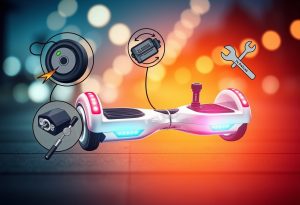Urban traffic congestion has become a major issue in many cities around the world, leading to increased travel times, air pollution, and frustration for commuters. As cities continue to grow, finding sustainable and efficient solutions to reduce traffic congestion has become a top priority. One solution that has gained traction in recent years is the use of electric scooters. Electric scooters provide a versatile and eco-friendly mode of transportation that can help alleviate traffic congestion in urban areas. In this blog post, we will explore how electric scooters contribute to reducing urban traffic congestion and the benefits they offer to both individuals and the community as a whole.
Table of Contents
ToggleUnderstanding Electric Scooters
Before delving into the ways electric scooters help in reducing urban traffic congestion, it’s important to understand the technology behind these innovative vehicles. Electric scooters are powered by electric motors and are designed to be eco-friendly and efficient modes of transportation in urban areas. With their compact size and zero emissions, electric scooters have become increasingly popular as a solution to urban traffic congestion.
The Rise of Electric Scooters in Urban Areas
Electric scooters have gained immense popularity in urban areas as a convenient and eco-friendly mode of transportation. As cities continue to grapple with traffic congestion and pollution, electric scooters have emerged as a viable solution to these challenges. Riders can easily navigate through traffic and reach their destinations in a timely manner, while also reducing their carbon footprint. The convenience and sustainability of electric scooters have led to their widespread adoption in urban settings.
Key Features and Technology
Understanding the key features and technology behind electric scooters is essential in recognizing their significant impact on urban traffic congestion. Some key features of electric scooters include:
- Compact design for easy maneuverability
- Electric motor for zero emissions
- Long-lasting battery for extended range
- Smart connectivity for enhanced navigation
This advanced technology enables electric scooters to be a practical and sustainable mode of transportation in urban areas, contributing to the reduction of traffic congestion and environmental pollution.
Electric Scooters and Traffic Flow
The introduction of electric scooters has had a significant impact on urban traffic flow. These compact and efficient vehicles offer a sustainable and convenient mode of transportation for urban dwellers, resulting in reduced traffic congestion and improved overall traffic flow in city centers.
Impact on Urban Traffic Patterns
Electric scooters have disrupted traditional traffic patterns in urban areas by providing a viable alternative to cars and public transportation. With the ability to navigate through crowded streets and narrow lanes, electric scooters allow commuters to bypass traffic jams and reach their destinations more efficiently. As a result, the overall traffic patterns in cities have become smoother, with fewer vehicles clogging the roads during peak hours.
Case Studies: Electric Scooters in Major Cities
- The implementation of electric scooters in Los Angeles resulted in a 22% decrease in car usage for short-distance trips within the city.
- In Portland, the adoption of electric scooters led to a 15% reduction in rush hour traffic, easing congestion in downtown areas.
- Paris saw a 30% decrease in carbon emissions from transportation after the introduction of electric scooters as a popular mode of urban travel.
Urban planners and transportation authorities have recognized the impact of electric scooters on traffic congestion, and many cities are actively integrating these vehicles into their infrastructure to alleviate urban traffic problems.
Benefits and Challenges
To fully understand the impact of electric scooters on urban traffic congestion, it is important to consider both the benefits they bring and the challenges they present. Electric scooters offer environmental and economic benefits, but they also come with regulatory and safety challenges.
Environmental and Economic Benefits
The use of electric scooters in urban areas can lead to significant reductions in air pollution and greenhouse gas emissions. By choosing electric scooters over traditional vehicles, individuals can contribute to cleaner air and a healthier environment. In addition to the environmental benefits, electric scooters can also bring economic advantages. They provide a cost-effective mode of transportation for short-distance commutes, reducing the reliance on expensive fuel and parking fees.
Regulatory and Safety Challenges
To maximize the benefits of electric scooters, it is crucial to address regulatory and safety challenges. The introduction of electric scooters in urban environments has raised concerns about the potential for accidents and conflicts with other road users. In addition, there are issues related to the proper integration of electric scooters into existing transportation infrastructure and the development of appropriate regulations to govern their use.
Safety measures, such as mandatory helmet use and speed limits, are essential in mitigating the risks associated with electric scooters. Regulatory frameworks need to be established to ensure the safe and responsible operation of electric scooters in urban areas, taking into account the diverse needs and concerns of all stakeholders.
Strategies for Integration
After recognizing the potential of electric scooters in reducing urban traffic congestion, it is essential to consider strategies for their effective integration into the existing urban infrastructure. This involves urban planning for scooter-friendly cities and collaboration between governments and service providers to ensure seamless integration and operation.
Urban Planning for Scooter-Friendly Cities
Scooter-friendly cities need to adapt their urban planning strategies to accommodate the growing use of electric scooters. This includes creating designated lanes and parking areas for scooters, as well as incorporating them into existing public transportation networks. Urban planners need to consider the safety and convenience of scooter riders, as well as the impact on pedestrian and vehicle traffic.
Furthermore, integrating electric scooters into urban planning can also involve updating traffic laws and regulations to reflect their presence on city streets. This may include establishing speed limits, helmet requirements, and rules for parking and riding in specific areas.
Collaboration Between Governments and Service Providers
The collaboration between governments and service providers is crucial in ensuring the successful integration of electric scooters into urban environments. The government plays a key role in setting regulations and standards for scooter operations, including licensing requirements and safety guidelines. Meanwhile, service providers need to work closely with local authorities to ensure compliance with these regulations and to address any concerns related to scooter deployment and management.
Any successful integration of electric scooters into urban transportation systems requires open communication and collaboration between all involved parties. This includes addressing issues such as rider behavior, parking availability, and the impact on other modes of transportation. By working together, governments and service providers can create a framework for the responsible and effective use of electric scooters in reducing urban traffic congestion.
Conclusively, Electric Scooters Help in Reducing Urban Traffic Congestion
Electric scooters are a practical and sustainable solution to urban traffic congestion. With the ability to navigate through narrow streets and bypass traffic jams, electric scooters provide an efficient and eco-friendly mode of transportation. By encouraging individuals to opt for electric scooters over traditional vehicles, cities can see a significant reduction in traffic congestion, leading to less air pollution and a more efficient transportation network. Additionally, electric scooters promote a healthier lifestyle and contribute to a more sustainable urban environment. As cities continue to explore innovative ways to address traffic congestion, electric scooters present a promising solution that can have a positive impact on urban mobility.






